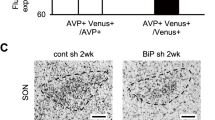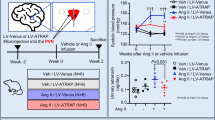Abstract
The ability of adenovirus (Ad) to transfect most cell types efficiently1–3 has already resulted in human gene therapy trials involving the systemic administration of adenoviral constructs4. However, because of the complexity of brain function and the difficulty in noninvasively monitoring alterations in neuronal gene expression, the potential of Ad gene therapy strategies for treating disorders of the CNS has been difficult to assess. In the present study, we have used an Ad encoding the arginine vasopressin cDNA (AdAVP)5 in an AVP-deficient animal model of diabetes insipidus (the Brattleboro rat6), which allowed us to monitor chronically the success of the gene therapy treatment by noninvasive assays. Injection of AdAVP into the supraoptic nuclei (SON) of the hypothalamus resulted in expression of AVP in magnocellular neurons. This was accompanied by reduced daily water intake and urine volume, as well as increased urine osmolality lasting 4 months. These data show that a single gene defect leading to a neurological disorder can be corrected with an adenovirus-based strategy. This study highlights the potential of using Ad gene therapy for the long-term treatment of disorders of the CNS.
This is a preview of subscription content, access via your institution
Access options
Subscribe to this journal
Receive 12 print issues and online access
$209.00 per year
only $17.42 per issue
Buy this article
- Purchase on Springer Link
- Instant access to full article PDF
Prices may be subject to local taxes which are calculated during checkout
Similar content being viewed by others
References
Cheng, D.Y., Kolls, J.K., Lei, D.H. & Noel, R.A. In vivo and in vitro gene transfer and expression in rat intestinal epithelial cells by E1-deleted adenoviral vector. Hum. Gene Ther. 8, 755–764 (1997).
Neve, R.L. Adenoviral vectors enter the brain. Trends Neurosci. 16, 251–253 (1993).
Geddes, B.J. et al. Persistent transgene expression in the hypothatamus following stereotaxic delivery of a recombinant adenovirus- suppression of the immune response with cyclosporine. Endocrinology 137, 5166–5169 (1996).
Wagner, J.A. & Gardner, P. Toward cystic fibrosis gene therapy. Anna. Rev. Med. 48, 203–216 (1997).
Foo, N-C., Funkhouser, J.M., Carter, D.A. & Murphy, D. A testis-specific promoter in the rat vasopressin gene. J. Biol. Chem. 269, 659–667 (1994).
Valtin, H. Hereditary diabetes insipidus in rats (Brattleboro strain). Am. J. Med. 42, 814–827 (1967).
Gainer, H. & Wray, S. Cellular and molecular biology of oxytocin and vasopressin. in The Physiology of Reproduction, 2nd edn. (eds. E. Knobil & Neill) 4545–472 (Raven, New York, 1994).
Burbach, J.P.H. et al. Differential responses to osmotic stress of vasopressin mRNA in hypothalamic nuclei. Neuroendocrinology 39, 582–584 (1984).
Sherman, T.G., Civelli, O., Douglas, J., Herbert, E. & Watson, S.J. Coordinate expression of hypothalamic pro-dynorphin and pro-vasopressin mRNAs with osmotic stimulation. Neuroendocrinology 44, 222–228 (1986).
Schmale, H. & Richter, D. Single base deletion in the vasopressin gene is the cause of diabetes insipidus in Brattleboro rats. Nature 308, 705–709 (1984).
Ivell, R., Burback, P.H. & Van Leeuwen, F.W. The molecular biology of the Brattleboro rat. Front. Neuroendocrinol. 4, 313–338 (1990).
Repaske, D.R. & Phillips, J.A. The molecular biology of human hereditary diabetes insipidus. Prog. Brain Res. 93, 295–308 (1992).
Jirikowski, G.F., Sanna, P.P., Maciejewski-Lenoir, D. & Bloom, F.E. Reversal of diabetes insipidus in Brattleboro rats: Intrahypothalamic injection of vasopressin mRNA. Science 255, 996–998 (1992).
Ben-Barak, Y., Russell, J.T., Whitnall, M.H., Ozato, K. & Gainer, H. Neurophysin in the hypothalamo-neurohypophysial system. I. Production and characterization of monoclonal antibodies. J. Neurosci. 5, 81–97 (1985).
van Leeuwen, F.W., Evans, D.A.P., Meloen, R. & Sonnemans, M.A.F. Differential neurophysin immunoreactivities in solitary magnocellular neurons of the homozygous Brattleboro rat indicate an altered neurophysin moiety. Brain Res. 635, 328–330 (1994).
Whitnall, M.H., Key, S., Ben-Barak, Y., Ozato, K. & Gainer, H. Neurophysin in the hypothalamo-neurohypophysial system. II. immunocytochemical studies of the ontogeny of oxytocinergic and vasopressinergic neurones. J. Neurosci. 5, 98–109 (1985).
Pow, D.V., Morris, J.F. & Ward, A.R. Immuno-electron microscopic evidence for two different types of partial somatic repair of the mutant Brattleboro vasopressin gene. Neuroscience 50, 503–512 (1992).
Graham, F.L. & Prevec, L. Methods for construction of adenovirus vectors. Mol. Biotech. 3, 207–220 (1995).
Sofroniew, M.V. (1985) Vasopressin, oxytocin and their related neurophysins. in Handbook of Chemical Neuroanatomy. Vol. 4: GABA and neuropeptides in the CNS, Part 1 (eds. Bjorklund, A. & Hokfelt, T.) 35–44 (Elsevier, London, 1985).
Harbuz, M.S. & Lightman, S.L. Response of hypothalamic and pituitary mRNA to physical and psychological stress in the rat. J. Endo. (Lond.) 122, 705–711 (1989).
Author information
Authors and Affiliations
Rights and permissions
About this article
Cite this article
Geddes, B., Harding, T., Lightman, S. et al. Long-term gene therapy in the CNS: Reversal of hypothalamic diabetes insipidus in the Brattleboro rat by using an adenovirus expressing arginine vasopressin. Nat Med 3, 1402–1404 (1997). https://doi.org/10.1038/nm1297-1402
Received:
Accepted:
Issue Date:
DOI: https://doi.org/10.1038/nm1297-1402
This article is cited by
-
Rat models of human diseases and related phenotypes: a systematic inventory of the causative genes
Journal of Biomedical Science (2020)
-
Viral rescue of magnocellular vasopressin cells in adolescent Brattleboro rats ameliorates diabetes insipidus, but not the hypoaroused phenotype
Scientific Reports (2019)
-
In vitro and in vivo analysis of expression cassettes designed for vascular gene transfer
Gene Therapy (2008)
-
Restorative effect of insulin-like growth factor-I gene therapy in the hypothalamus of senile rats with dopaminergic dysfunction
Gene Therapy (2007)
-
Effects of ectopic decorin in modulating intracranial glioma progression in vivo, in a rat syngeneic model
Cancer Gene Therapy (2004)



